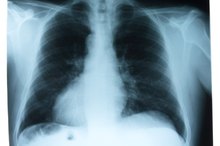The DuPont Company invented the synthetic rubber neoprene in 1930, which is also known as polychloroprene. It is a polymer used in many diverse applications such as wet suits, adhesives, and Velcro. It can be a solid or a liquid and is considered chemically stable. Neoprene itself is not considered toxic. However, gases from neoprene production may be hazardous, and some adhesives containing neoprene may cause skin sensitivity.
Colophony Skin Sensitization
In 2002 the European Union Dangerous Preparations Directive 1999/45/EC classified colophony, which is usually found in tree resin, as a skin contact sensitizer. Neoprene adhesives have about four percent colophony, which is also called rosin. The European Union states that a colophony level of 0.1 percent or greater must be labeled and may pose as a skin contact sensitizer. DuPont recommends manufacturers of adhesives with neoprene determine whether or not colophony levels are above 0.1 percent, which then need mandatory labeling.
- In 2002 the European Union Dangerous Preparations Directive 1999/45/EC classified colophony, which is usually found in tree resin, as a skin contact sensitizer.
- The European Union states that a colophony level of 0.1 percent or greater must be labeled and may pose as a skin contact sensitizer.
Static Charge and Hydrogen Chloride
What Are the Dangers of Ethylene Vinyl Acetate?
Learn More
Solid neoprene comes in chips that may accumulate electrical static charge during packing and shipping. The National Fire Protection Association recommends that warehouses storing neoprene display warning signs because electrical static charges may pose a fire risk. If neoprene is burned in a fire, hydrogen chloride gas is released. Hydrogen chloride is considered a severe eye and respiratory irritant. Animals exposed to high levels of this chemical developed tracheal and bronchial necrosis. 1,350 parts per million of hydrogen chloride gas causes clouding in the cornea after 90 minutes, and it may also cause dental discoloration and burns in nasal membranes.
- Solid neoprene comes in chips that may accumulate electrical static charge during packing and shipping.
Talc Dust Inhalation
Talc is used in the packaging of neoprene solids, and long-term inhalation of talc dust may cause lung disease. Talc has low levels of crystalline silica, which become airborne during the movement of neoprene chips. DuPont considers talc to be a human carcinogen because laboratory rats exposed to it had increased lung inflammation and adrenal and lung tumors. Handling neoprene must be done wile using a respirator in a well-ventilated room.
- Talc is used in the packaging of neoprene solids, and long-term inhalation of talc dust may cause lung disease.
Butadiene from Neoprene
Toxic Vapors Emitted From New Tires
Learn More
The EPA has listed butadiene as a toxic pollutant, and it may be released as a gas during neoprene production 34. A study done at the EPA's Atmospheric Research and Exposure Assessment Laboratory showed emission levels of butadiene at two to 40 percent when processing neoprene 34. Acute low-level exposure to butadiene causes eye, throat and other respiratory irritation 4. Acute high-level exposure to butadiene may cause nausea, lowering of the pulse and damage to the central nervous system 4. It is debatable whether or not it is a true carcinogen.
Related Articles
References
Writer Bio
Charong Chow has been writing professionally since 1995. Her work has appeared in magazines such as "Zing" and "Ocean Drive." Chow graduated from the University of Miami with a Bachelor of Arts in philosophy. She also received a Bachelor of Fine Arts from the California Institute of the Arts.






